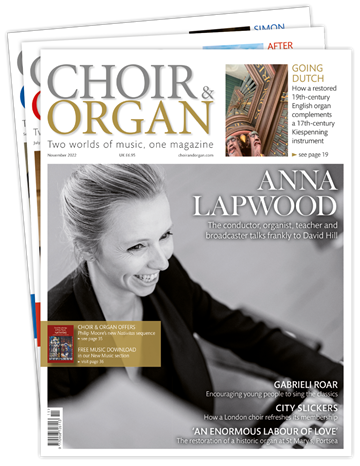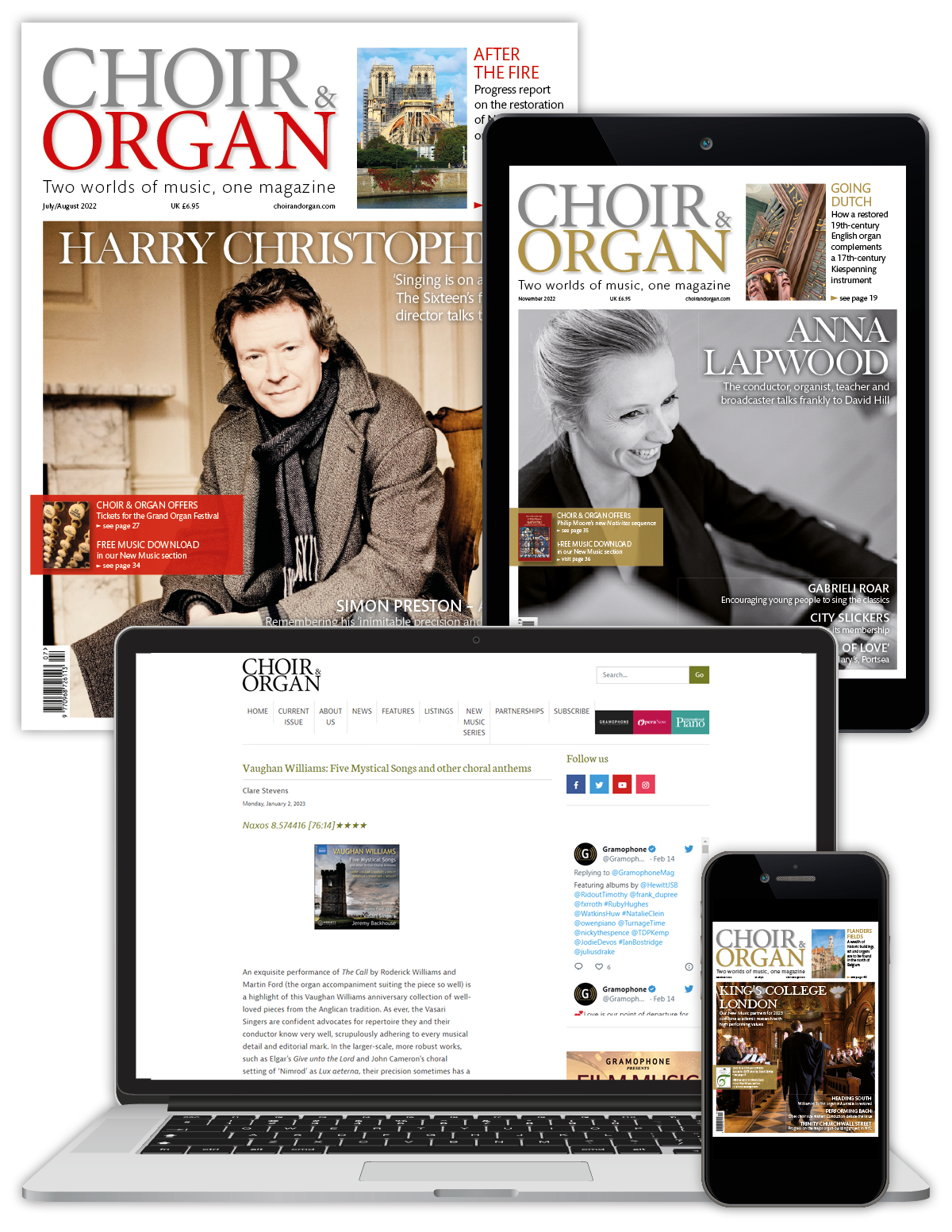Musica Viva: sounds of the city
Clare Stevens
Friday, February 23, 2024
With a commitment to new music and diverse composers, New York City choir Musica Viva is paving the way for daring collaborations

The clue is in the name: the concert repertoire of Musica Viva NY (MVNY) does regularly include Bach cantatas and works by the likes of Mozart, Brahms, Duruflé and Bernstein, but the choir’s USP is its commitment to performing the work of living American composers, together with music by women composers, composers of colour and works that address social, racial or environmental issues. The current season demonstrates that commitment wholeheartedly, and has included recording three of its recent commissions for commercial release in the autumn of 2024.
MVNY is a chamber choir of around 30 singers, some of whom are professional and others skilled volunteers – alumni include the soprano Renée Fleming and the bass-baritone Samuel Ramey. It was founded in 1977 by Walter Klauss, then organist of the Unitarian Universalist Church of All Souls, Lexington Avenue, on the Upper East Side of Manhattan, where it is still based. In 2015 Klauss was succeeded as director of music at the church and artistic director of MVNY by Alejandro Hernandez-Valdez, who steered the ensemble through the challenges of the global pandemic and is now getting back on track with his vision for future projects.
‘I love to collaborate with composers ... it’s so great to be able to pick up the phone and ask them all those questions that you can’t ask Beethoven or Mozart’
‘Walter Klauss – “Wally”, as we call him – was a real force of nature. He created a lot of wonderful opportunities for the choir; they toured Europe a few times, and did a couple of recordings,’ says Hernandez-Valdez, explaining that MVNY eventually became independent from All Souls, as a non-profit organisation with its own board, although the personnel in the All Souls choir who sing on Sundays and the Musica Viva NY concert choir are essentially the same. ‘When I came along, of course I had my own ideas, but the bones of the organisation were already so well established that it was just a pleasure to be able to come in and do what I wanted to do.’
Mexican by birth, from the age of eight Hernandez-Valdez sang in a children’s choir in Guadalajara, where his father was principal bass in the symphony orchestra. At 17 he won a scholarship to study piano at the Shenandoah Conservatory in Virginia, but he started teaching himself to conduct from sheet music and CDs as a teenager, and switched his academic studies from piano to conducting at post-doctoral level, largely because it is a more sociable activity. He has been artistic director of the Victoria Bach Festival in Texas since 2016 and is also co-founder and artistic director of the New Orchestra of Washington (NOW).
At All Souls he is assisted by organist and composer Trent Johnson, who accompanies the choir and stands in as conductor if Hernandez-Valdez has to be away. He runs a community choir that sings at All Souls every few weeks, and is also closely involved with MVNY’s growing programme of community engagement work, which includes visits to local schools and libraries with small groups of singers: ‘I always say I couldn’t do my work without Trent,’ says Hernandez-Valdez. ‘The choir and the instrumentalists we work with love him, and because he is a composer as well, he understands the music from the inside out.’ For his part Johnson says, ‘The breadth of repertoire and especially the quantity of new music we explore together is one of the things that makes working at All Souls and with Alejandro so satisfying. Many of our new works are written by people from different ethnic groups, so there is inclusivity in the commissioning process as well, and even for many of our singers in the Musica Viva NY choir one of the big draws is repertoire. I was talking to one of our singers recently and he said, “You know I really enjoyed my last choir, but we never performed anything past 1750!” ’
‘Once I became a conductor, one of my ambitions was to commission as many new works as possible,’ Hernandez-Valdez continues. ‘I love to collaborate with composers; I just love the huge advantage of being able to work with them on the creative process of giving birth to a new piece of music. It’s so great to be able to pick up the phone and ask them all those questions that you can’t ask Beethoven or Mozart.’
As an example, he recalls the process of commissioning and performing Joseph Turrin’s 45-minute cantata And Crimson Roses Once Again Be Fair, the title track of the forthcoming Naxos CD. A First World War centenary co-commission, first performed by MVNY with the NOW and the Washington Master Chorale in 2018 to mark the anniversary of the Armistice, it sets poems by Siegfried Sassoon, Wilfred Owen, Vera Brittain and others who fought, died or were bereaved in the conflict. ‘It was such a rewarding process – watching lots of documentaries about the First World War, about the Armistice, reading a lot of books – obviously it’s Joe’s piece, but it was a wonderful collaboration. For me the most remarkable aspect of the cantata is how the heart-wrenching poetry absolutely guides the music throughout.’
The apex of the piece in terms of both text (Vera Brittain’s poem ‘Perhaps’) and music is the penultimate movement – a mezzo-soprano solo, for which the composer had in mind the voice of the legendary Frederica von Stade. She is now largely retired, but she generously agreed to take part in this recording project. The piece has a particular resonance for her, she says, because her father was killed in the Second World War while her mother was expecting her. ‘She never got over losing him, so I’m kind of creating this wonderful chance to honour her.’
Hernandez-Valdez chose two other MVNY commissions that spoke to him very directly to sit alongside Crimson Roses. Gilda Lyon’s Momotombo for a cappella chorus sets a poem by Rubén Darío, inspired by the spectacular volcanic landscape of Nicaragua. ‘Gilda is a wonderful singer as well as a composer. Her family is from Nicaragua, and this piece speaks to her roots and the love she has for Latin American culture in general. As a Latin American person myself, I was very drawn to that idea,’ he explains.
‘And then the third piece is The Luminous Ground, for SATB chorus, strings and piano, by Richard Einhorn. He has an incredible background as a composer and a music producer – he has produced records for people like Glenn Gould and Yo-Yo Ma, all the greatest. He is also a Buddhist, a very spiritual person; having a conversation with him is a wonderful, calming experience. I met him through Pamela Patton, one of our ministers at All Souls who is also a Buddhist, and he wrote a piece that we performed at one of our services; then I asked if he would write something for full choir and strings, and he came up with this beautiful work, which we premiered in March 2023.’
The title refers to that stage in a person’s progress towards enlightenment when, according to the Buddhist philosopher Nāgārjuna, the ‘pacifying light of wisdom dawns’ and ‘attachment and aversion have thoroughly ceased’ … leading to ‘a nearly unimaginable state of serenity,’ says Einhorn, adding that this transcendent state is evoked for him by the light sculptures of James Turrell, which he has tried to match with a slow, gradually changing soundscape.
Asked about the relationship between liturgy and music in a Unitarian Universalist congregation, compared to, say, Episcopalian or Roman Catholic, Hernandez-Valdez agrees that the repertoire is more wide-ranging, but adds that All Souls has its own way of making music and its own traditions, which he inherited from Walter Klauss, and which are not typical.
Invited to elaborate on this, as an organist who has worked in many churches, Trent Johnson says that All Souls is not attached to dogmas and creeds: ‘It’s more open to the entire world, let’s put it that way – I would even say that unitarians are all-inclusive. People from many different backgrounds Christians, non-Christians, atheists, agnostics, Muslims – all are truly welcome. The music reflects all of those various traditions, so we might have some anthems that are Christian-based, some that are based on a Muslim text or maybe on secular poetry. We have a wide range of musical sources that we can draw from to create a varied programme each week.’
This has its advantages and disadvantages, says Hernandez-Valdez. It is rewarding to have such a wide choice, but a lot of the canon has been written for the Christian liturgy and theology. Nevertheless, both men feel that the bright, welcoming space of All Souls, the preaching of its team of ministers from different traditions, and the music offer enrichment and solace to people who are searching for comfort and inspiration, a different way of thinking in this troubled world.
As for the choir members, Hernandez-Valdez says they are ‘a group of people who get along and get a lot done.
‘I have worked with a lot of groups in my career, and each group has its own personality, but there is something about the Musica Viva NY organisation and the choir and the church – it has a very special personality and a big heart, and I think more people should experience what we are striving to accomplish.’
Clare Stevens works as a writer, editor and publicist in the Welsh Marches
This article originally appeared in the Spring 2024 issue of Choir & Organ magazine. Never miss an issue – subscribe today






